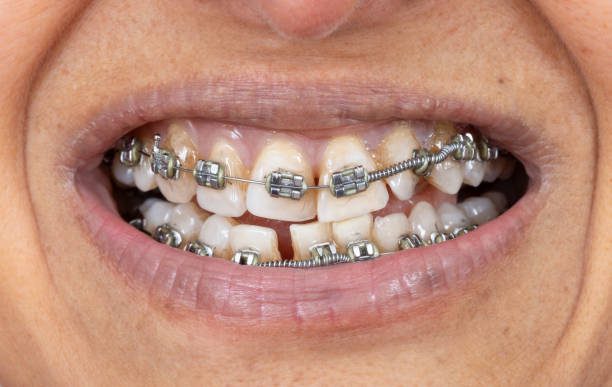⚠️ Medical Disclaimer
Important: This content is for informational and educational purposes only. It should not be used as a substitute for professional medical advice, diagnosis, or treatment. Always consult with a qualified healthcare provider before making changes to your diet, taking supplements, or if you have questions about a medical condition. Never disregard professional medical advice or delay seeking it because of information you read here.
Last Updated on February 22, 2024 by Grace Oluchi
Welcome to our comprehensive guide on crooked teeth! Having misaligned or crooked teeth can impact your confidence, oral health, and overall well-being. In this article, we will explore its causes, the potential health implications, and the various treatment options available. Whether you’re seeking orthodontic solutions or looking to understand more about crooked teeth. Join us as we delve into this common dental issue and learn how to achieve a straighter, healthier smile.
What is Crooked teeth?
Crooked teeth, also known as malocclusion or misaligned teeth. This refers to teeth that do not have proper alignment or do not fit correctly when you close your jaw. This dental condition can manifest in various ways, including crowded teeth, gaps between teeth, rotated teeth, or an improper bite. It can be a result of genetic factors, inadequate jaw development, or other oral habits. Besides aesthetic concerns, crooked teeth can also lead to dental issues like increased risk of tooth decay and gum disease. Fortunately, there are various orthodontic treatments available to correct it and achieve a straighter, healthier smile.
What Causes Crooked Teeth?
- Genetic factors: Inherited traits from parents, such as jaw size, tooth size, and dental structure, can contribute to it.
- Inadequate jaw development: Insufficient growth of the jaw bones can result in crowded teeth or misalignments.
- Early loss of primary teeth: Premature loss of baby teeth can disrupt the alignment of permanent teeth as they erupt.
- Thumb-sucking and pacifier use: Prolonged habits like thumb-sucking or pacifier use can affect the positioning of teeth and jaw development.
- Mouth breathing: Breathing through the mouth instead of the nose impacts the growth of the jaws and cause dental misalignments.
- Oral habits: Activities like tongue thrusting, thumb-sucking, or prolonged use of bottles or sippy cups can contribute to it by putting pressure on the teeth or affecting the positioning of the jaw.
Issues Caused by Crooked Teeth.
- Difficulty in proper oral hygiene: it can make it challenging to clean teeth effectively, leading to an increased risk of tooth decay and gum disease.
- Uneven wear and tear: Misaligned teeth can create uneven pressure while biting and chewing, causing excessive wear on certain teeth.
- Speech problems: Crooked teeth can lead to speech difficulties, such as lisping or difficulty pronouncing certain sounds.
- Self-consciousness: People with crooked teeth may feel self-conscious about their smile, impacting their self-esteem and confidence.
- Increased risk of dental injuries: Protruding or misaligned teeth are more susceptible to trauma, increasing the risk of fractures or other dental injuries.
- Temporomandibular joint (TMJ) disorders: Crooked teeth can contribute to jaw misalignment, leading to TMJ disorders and associated pain, clicking, or difficulty in jaw movement.
- Digestive issues: Improperly aligned teeth can affect the chewing process, leading to inadequate breakdown of food and potential digestive problems.
- Headaches and migraines: Crooked teeth may contribute to bite misalignment, which can result in chronic headaches and migraines.
- Sleep apnea and breathing difficulties: Certain dental misalignments can obstruct the airway, contributing to sleep apnea or breathing difficulties during sleep.
- Aesthetic concerns: Crooked teeth can affect the overall appearance of the smile, impacting facial aesthetics and symmetry.
Should Crooked Teeth be Straightened?
Yes, it is generally recommended to straighten crooked teeth. Straightening crooked teeth offers numerous benefits, both for oral health and overall well-being. Here are a few reasons why crooked teeth should be straightened:
- Improved oral hygiene: Straight teeth are easier to clean, allowing for better oral hygiene practices and reducing the risk of tooth decay, gum disease, and other dental issues.
- Enhanced aesthetics: Straightening crooked teeth can greatly improve the appearance of your smile, boosting self-confidence and overall facial aesthetics.
- Bite alignment and function: Properly aligned teeth contribute to a well-balanced bite, reducing the risk of jaw problems, headaches, and uneven wear on teeth.
- Speech improvement: Correcting misaligned teeth can help improve speech difficulties caused by crooked teeth, such as lisping or difficulty pronouncing certain sounds.
- Reduced risk of dental injuries: Straight teeth are less likely to experience dental trauma or injuries due to protrusion or misalignment.
- Improved overall health: Crooked teeth can contribute to various health issues, including digestive problems, sleep apnea, and even cardiovascular conditions. Straightening teeth can help mitigate these risks.
Options for Teeth Straightening.


There are several options available for teeth straightening, depending on the severity of misalignment and individual preferences. Here are seven common methods:
- Traditional braces: Metal or ceramic brackets are bonded to the teeth, connected by wires and adjusted periodically to gradually shift the teeth into proper alignment.
- Clear aligners: Custom-made, removable aligners (e.g., Invisalign) are virtually invisible and provide a discreet option for straightening teeth. They are replaced every few weeks to progress the alignment.
- Lingual braces: Similar to traditional braces, lingual braces are placed on the backside of the teeth, making them less visible from the front.
- Self-ligating braces: These braces use specialized brackets that eliminate the need for elastic bands, allowing for more comfortable tooth movement.
- Ceramic braces: Tooth-colored or clear ceramic brackets blend with the natural tooth color, making them less noticeable than traditional metal braces.
- Retainers: Retainers are often used after braces or aligner treatment to maintain the corrected position of teeth.
- Dental veneers: In some cases, if misalignment is mild, dental veneers can be an option. Veneers are thin shells bonded to the front of the teeth to create the appearance of straight teeth.
What Should I Expect When I See a Dentist or Orthodontist About my Crooked Teeth?
When you see a dentist or orthodontist about your crooked teeth, you can expect a comprehensive evaluation and discussion regarding your specific concerns. Here is what you can typically expect during your visit:
- Initial consultation: The dentist or orthodontist will begin by discussing your dental and medical history, along with any concerns or goals you have regarding your crooked teeth.
- Examination and assessment: A thorough examination of your teeth, jaw, and bite will be performed. This may involve taking X-rays, photographs, and impressions of your teeth to create models for analysis.
- Diagnosis and treatment recommendation: Based on the examination findings, the dentist or orthodontist will diagnose the nature and severity of your crooked teeth. They will then discuss different treatment options suitable for your specific case, explaining the benefits, duration, and potential costs associated with each option.
- Treatment planning: If you decide to proceed with treatment, the dentist or orthodontist will develop a personalized treatment plan tailored to your needs. They will outline the steps involved, provide an estimated timeline, and address any concerns or questions you may have.
- Financial considerations: The dental team will discuss the cost of the proposed treatment and the available payment options. They may also provide information on dental insurance coverage and any financing options available.
- Ongoing monitoring and follow-up: Once your treatment begins, regular appointments will be scheduled to monitor progress, make adjustments as needed, and ensure that your teeth are moving in the desired direction.
How Much does it Cost to Fix Crooked Teeth?
Price range is $3,000 to $8,000. The cost of fixing crooked teeth varies depending on several factors. It is challenging to provide an exact cost without evaluating your individual case. However, to give you a rough estimate, traditional braces typically range from $3,000 to $7,000, while clear aligners like Invisalign may cost between $3,000 and $8,000. Lingual braces and other specialized treatments may have higher costs. It’s important to consult with a dental professional to receive an accurate assessment and discuss the cost of treatment options specific to your case. They can provide detailed information on payment plans, insurance coverage, and financing options available to make the cost of treatment more manageable.
The Key Takeaway.
Crooked teeth can have a significant impact on both oral health and self-confidence. However, with the numerous teeth straightening options available today, achieving a straighter and healthier smile is within reach for many individuals. Whether you opt for traditional braces, clear aligners, or other orthodontic treatments, addressing it offers a range of benefits, including improved oral hygiene, enhanced aesthetics, better bite alignment, and reduced risks of dental injuries and associated health issues. It is essential to consult with a qualified dentist or orthodontist who can assess your specific needs and guide you towards the most suitable treatment option. Don’t let crooked teeth hold you back – take the first step towards a confident and aligned smile today.
FAQs on Crooked Teeth.
Can crooked teeth cause oral health problems?
Yes, crooked teeth can contribute to various oral health problems. Misaligned teeth can make it difficult to clean properly, increasing the risk of tooth decay, gum disease, and bad breath. Crooked teeth can also lead to uneven wear and tear on teeth, jaw problems, and even speech difficulties.
Can crooked teeth be fixed without braces?
Yes, depending on the severity and specific case, there are alternatives to traditional braces. Clear aligners, lingual braces (braces placed on the backside of teeth), and veneers are some options to consider. Consulting with a dentist or orthodontist will help determine the best treatment for your crooked teeth.
At what age should crooked teeth be treated?
Orthodontic treatment for crooked teeth is not limited to any specific age range. Children, teenagers, and adults can all pursue treatment options. In fact, early intervention in childhood can often lead to more effective and efficient results.
How long does it take to straighten crooked teeth?
The duration of treatment varies depending on the severity of misalignment and the chosen treatment method. It can range from a few months to a few years. Your dentist or orthodontist will provide an estimated timeline based on your specific situation.
Will fixing crooked teeth improve my smile's appearance?
Yes, straightening crooked teeth can greatly enhance the appearance of your smile. It can improve overall facial aesthetics, boost self-confidence, and create a more harmonious balance in your facial features. It’s important to discuss your expectations with a dental professional to ensure realistic and achievable results.

